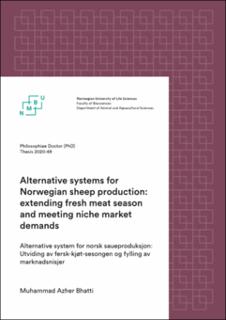| dc.description.abstract | Norway has the largest sheep population (>1 million winterfed ewes) in Scandinavia. Sheep farming is taken as a part-time activity by most farmers. The focus of this PhD study has been on increasing year-round fresh meat availability, exploring the new niche meat (halal) markets (such as Muslim festivals), and to increase the sustainability of sheep farming (economic analysis) and the meat industry (meat sensory and consumer analysis) in Norway. In paper 1, an overview of the whole Norwegian sheep farming and new niche market is provided. The sheep farming system is adapted to produce most of the lamb crop (slaughtered) over a three- to four month period from September to December with a peak in September-November. The concentrated slaughtering season has reduced the availability of slaughter animals for rest of the year, thereby limiting year-round fresh meat availability. Additionally, a large quantity of frozen meat (lamb and sheep) has exerted huge pressure on the storage facilities and disturbed the market supply and demand balance. This led to overall lower meat prices and has affected the meat consumers’ appeal to and consumption of lamb/sheep meat. To overcome the limited out of season meat supply, a better understanding of the Norwegian sheep farming system as a whole, and some critical factors, is vital for the creation of sustainable sheep meat production. Summer range grazing (90-100 days), winter indoor feeding, and meat market price, are the critical factors to be considered when suggesting any changes in the current practices. In paper 2, based on the Norwegian White sheep breed, linear optimisation was used to compare farm profitability (gross margin) of baseline practices with four different scenarios. The alternative scenarios were delayed lambing, hogget production, 1st lambing when two years old, and ewe longevity increased to 5.3 years with first lambing at two years of age. Hogget meat market price and availability of autumn pasture were the critical factors affecting gross margin for “hogget production” and “delayed lambing” scenarios respectively. Better market prices for the hogget meat would make it the most profitable production system. Increasing production life for Norwegian white sheep ewes to more than 5.3 years has the potential to produce more lamb meat per live weight of ewes. The calculated amount of concentrate feed used to produce one kg of meat was lower in the case of hogget production since hoggets mostly grazed and were not pregnant. In paper 3, the baseline sheep farming practices and four alternatives were the same as in paper 2, but the farm gross-margin of the two main breeds (Norwegian White sheep and Norwegian Spæl sheep) were now compared. Highest gross margin was calculated for the 4th alternative scenario (ewe production life increased to 5.3 years). The very low input meat prices for the hogget led to a lower gross margin for that alternative. Comparatively the Norwegian Spæl breed produced a higher gross margin compared with the Norwegian White sheep breed. The amount of concentrates used to produce one kilogram of meat was lower for two scenarios: hogget production and production life increased to 5.3 years. In paper 4, meat sensory profile of hogget and lamb meat was investigated with a trained sensory panel using quantitative descriptive analysis evaluated on an unstructured line scale from 1 (lowest intensity) to 9 (highest intensity). In total, 23 sensory attributes were analysed using the meat samples from 50 carcasses of lamb (5-monthold) and hogget (17 months old) of Norwegian White sheep and Norwegian Spæl sheep breeds. An effect (P<0.05) of animal age was found for the odour (fried roasted, sheep, and intensity), flavour (fried roasted, gamey, sheep, rancid, and liver), hardness, tenderness, fatness, and coarse fibre structural unit. Some of the flavour, juiciness, and tenderness scores were higher for lambs compared with hogget meat. Compared with Norwegian Spæl, the Norwegian White sheep breed obtained higher scores (P<0.05) for sheep odour, hardness and coarse fibre intensity. For the sensory attribute tenderness, Norwegian Spæl lamb, Norwegian Spæl hogget and Norwegian White sheep lamb scored similar while Norwegian White sheep hogget scored lower. Animal age and breed interaction (P<0.05) was found only for the fried roasted and gamey odour characteristics. Conclusively, it seems that Norwegian Spæl breed is less affected (in terms of meat sensory quality) by age compared with Norwegian White sheep breed. In paper 5, the purchasing intention for halal meat among Muslim meat consumers in Oslo was investigated by a Choice-Based Conjoint survey using the Sawtooth software. A latent class analysis was used to create consumer segments. The market share of some specific product concepts was re-estimated using a hierarchical Bayesian approach. The survey results showed that the majority of the meat consumers prefer to buy from halal butchers. In contrast, 2nd generation Norwegian born consumers gave 2nd preference to purchase halal meat from national supermarket chains. Trust is an important aspect when purchasing halal meat, and the market share would increase if the national supermarket chains had a wider range of halal meat products. An integration of halal butcher and national supermarket chains may have the potential to increase the trust and halal meat consumption among Norwegian Muslims. In conclusion, the Norwegian Spæl breed can be used for hogget production to fulfil the demand for fresh meat and religious festivals, while Norwegian White sheep farming to produce lambs rather than hogget is more profitable if ewe production life is increased to more than five years. The superior meat-eating quality of the Norwegian Spæl hogget should be advertised as a marketing strategy to get a better market price for hogget meat. To gain market share for halal meat, the national supermarket chains in Norway need to adjust their marketing strategy to include some of the services of the traditional halal butchers. | en_US |

